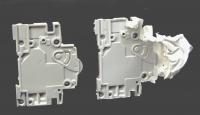plasticker-News
| 2009-10-26 |

|
LANXESS: High-current circuit-breakers made of polyamide 6
|
Specialty chemicals group LANXESS AG demonstrates that customized polyamide 6 and 66 grades are also able to meet the stringent demands made on electrical safety components by the example of a series-produced high-current circuit-breaker manufactured from Durethan DP BM 65 X FM30, a material based on polyamide 6. This halogen-, phosphorous- and antimony-free flame-retardant material offers more than just excellent mechanical and electrical properties. “The main reason for selecting this material was that it reduced processing costs. That in turn led to an overall reduction in the cost of the finished components,” explains Dr. Marcus Schaefer, an expert in electrical and electronic applications development in the LANXESS Semi-Crystalline Products business unit. Higher productivity, lower costs for finished components One factor that has paid off when it comes to the production of the high-current circuit-breaker is the fact that the cycle times for the polyamide – which is reinforced with 65 percent by weight mineral/glass fibers – are far shorter than those for urea and polyester resins. In addition, the component is flash-free. “With thermosets, flash necessitates laborious and often costly secondary finishing,” says Schaefer. Substitute for thermosets Until now, high-current circuit-breakers have been made mainly from urea and polyester resins. These thermoset materials were used for a number of reasons, including their high dielectric strength and tracking resistance, flame retardance, good resistance to temperature peaks and low mold and material costs. Compared with thermosets, highly reinforced thermoplastics in particular normally exhibit certain disadvantages in terms of flow behavior. However, the new XtremeFlow technology from LANXESS means this is not true of the polyamide used in these applications. Despite its high filler content, the thermoplastic is very easy flowing and can therefore be used even for very thin walls. What’s more, the isotropic shrinkage means the components suffer minimal distortion. Emission-free flame-retardance package “One further argument in favor of our material was that the flame-retardance package releases virtually no substances that could contaminate the contacts of the circuit-breaker over time,” adds Schaefer. The material fulfills fire safety standard UL 94 (Underwriters Laboratories) with a V-0 classification at a wall thickness of 0.75 millimeters. It passes the IEC 60695-2-12 glow-wire test with a GWFI (Glow Wire Flammability Index) value of 960 °C on a test piece 0.75 mm thick. The GWIT (Glow Wire Ignition Temperature) to IEC 60695-2-13 is 775 °C for a test piece of the same thickness. As a result, the material even meets the requirements laid down by the section of the IEC/EN 60335-1 standard for domestic appliances relating to plastics in unsupervised appliances (rated current > 0.2 A). The electrical properties are equally impressive. For example, the material has a tracking resistance (Comparative Tracking Index, IEC 60112) of over 600 volts. “The material’s high arc resistance represents an additional bonus in terms of electrical safety. This means the risk of short circuits and associated damage is very low,” comments Schaefer. More Information: www.lanxess.com |
LANXESS AG, Leverkusen, Germany
 back to news list back to news list |  back to top back to top |












